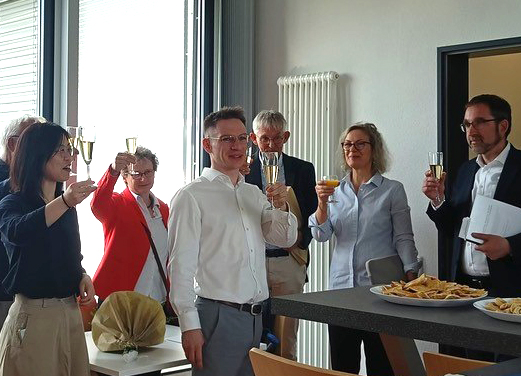On 17.07.2024, Tom Frederik Görtzen, M.Sc. successfully defended his scientific thesis as part of the doctoral procedure with the topic "Constructing simplicial surfaces with given geometric constraints". In addition to the chair of the doctoral committee, Prof. Dr. Arnold Reusken (RWTH Aachen University), the reviewers were Prof. Dr. Alice Niemeyer (RWTH Aachen University), Prof. Dr. Daniel Robertz (RWTH Aachen University), and Prof. Dr. Ghislain Fourier (RWTH Aachen University).
Abstract:
Simplicial surfaces encode the incidence relationships between vertices, edges, and faces of triangulated surfaces, providing a combinatorial description of these structures. By assigning a three-dimensional point to each vertex, we again obtain a triangulation, which we view as an embedded simplicial surface in the context of this thesis.The primary aim of this thesis is the construction of simplicial surfaces under specified geometric constraints, with a particular emphasis on symmetry. Symmetry, in mathematical terms, can be expressed using the language of group theory. Starting with a geometric object, we can determine its automorphism group by identifying all transformations that leave the object invariant. Conversely, from a group theoretic perspective, we can study groups independently and explore whether a geometric object exists such that its automorphism group matches a given group.Our first main result demonstrates that for any given finite group, we can construct a simplicial surface whose automorphism group is isomorphic to that group. In specific instances, these vertices can be embedded to produce embedded simplicial surfaces with given symmetry.Additionally, embedded simplicial surfaces can characterise other symmetric properties. For example, we explore systems of interlocked three-dimensional bodies, known as topological interlocking assemblies, which rely solely on their geometric properties. We demonstrate that the theory of planar crystallographic groups can be applied to construct a wide variety of interlocking assemblies. Moreover, we develop the mathematical foundations of interlocking assemblies containing a definition, a method for verifying the interlocking property and many examples. Furthermore, extending the action of planar crystallographic groups allows the creation of surfaces with doubly periodic symmetry.Embedded simplicial surfaces can be useful in various applications. In the final chapter, we illustrate how the theory of simplicial surfaces can be applied in the context of 3D printing: even if an initial model exhibits degenerations, we can modify it to produce a 3D printable file. Through these explorations, we highlight the practical and theoretical significance of simplicial surfaces in both mathematical research and technological applications, underscoring their versatility and potential for future developments.
We would like to congratulate Mr. Görtzen on completing his doctorate and wish him all the best and every success for his future as a scientist.





